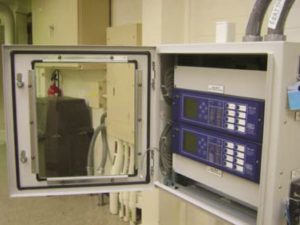Fission Stories #168
Fission Stories #111 described an electrical design problem that triggered an event on the Unit 2 reactor at the Byron nuclear plant in Illinois. This post is what radio broadcaster Paul Harvey called “the rest of the story.”
During its 26th annual Regulatory Information Conference March 12-14, 2014, the Nuclear Regulatory Commission (NRC) conducted a session called “Loss of Safety Functions—Undetected Open Phase(s) in Balanced Three-Phase Offsite Power System.” Admission was free, so I attended.
The panelists for this session were a representative from NRC’s headquarters office to discuss Bulletin 2012-01, “Design Vulnerability in Electric Power System” issued to all plant owners following the Byron event requiring them to evaluate their facilities for similar vulnerabilities, a representative from NRC’s regional office to discuss how the agency’s inspectors were going to examine plants for this problem, and Scot A. Greenlee, Senior Vice President for Engineering and Technical Services at Exelon Nuclear Generation, the company that owned and operated Byron.
Mr. Greenlee’s presentation recapped the design problems that triggered the January 2012 event at Byron and summarized the steps taken to identify its causes. Exelon determined that a specific vendor’s insulators used on power lines in the switchyard were more susceptible to failure than other insulator designs. Exelon developed plans to replace these susceptible insulators at all their nuclear plants, not just at Byron.
Even though Exelon planned measures to lessen the likelihood of another failure occurring, Mr. Greenlee also summarized the company’s efforts to better mitigate the problem. The January 2012 event at Byron involved the failure of the “C” phase in a three-phase power circuit. At the time, the voltage protection system intended to respond to such a failure only compared the voltage on the “A” phase against the voltage on the “B” phase. Consequently, the failure of the “C” phase went undetected and unmitigated. Exelon examined ways to also monitor the “C” phase voltage, but determined that these methods would successfully mitigate only about 80 percent of the credible open circuit failure modes.\
Not satisfied with 80 percent, Exelon researched and developed a micro-processor based protection system using three algorithms intended to react to real problems while avoiding false actuations.
Exelon is implementing this upgrade on all its nuclear plants, except Oyster Creek in New Jersey. Because Oyster Creek is scheduled to permanently closed in 2019, Exelon determined that upgraded response procedures and operator training would be sufficient for that plant’s remaining years.
In response to NRC Bulletin 2012-01, the nuclear industry plans to implement modifications to their facilities by December 31, 2016. The installed systems will be monitored and any necessary adjustments and recalibrations completed by December 31, 2017.
Our Takeaway
Exelon deserves recognition for fully fixing this safety problem. First, it identified a problem with insulators that increased the chances for a problem to occur. Second, it identified a problem with the system intended to mitigate this problem. Risk is defined as being the probability of a failure times its consequences. By taking steps to lower the probability as well as the consequences of this failure, Exelon significantly reduced the overall risk.
But Exelon did not stop there. The company decided to make its research and development efforts that culminated in the micro-processor based protection system available for free to the rest of the nuclear industry. I spoke with Mr. Greenlee after the session. He said there was some discussion within the company about marketing their product, but they ultimately decided to offer their design to others for free to hasten correction of this safety problem.
Everyone’s entitled to cash in on their labor. It is commendable that Exelon opted to make its efforts available to all seeking to significantly reduce the overall risk from this problem.
Thanks, Exelon.
“Fission Stories” is a weekly feature by Dave Lochbaum. For more information on nuclear power safety, see the nuclear safety section of UCS’s website and our interactive map, the Nuclear Power Information Tracker.

